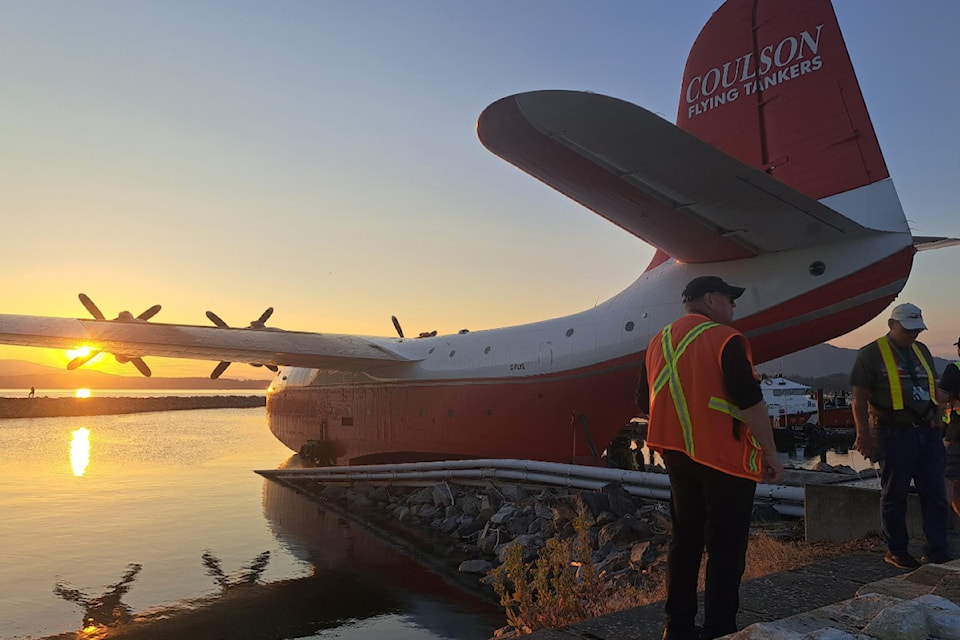The last shackles of a technically challenging move came off Thursday as Hawaii Mars settled into its next longtime resting place.
As Nickel Bros. crews disassembled the final pieces of the moving apparatus on Aug. 29, it marked the end of a 2.5-year mission made successful by more than 300 individuals and a dozen organizations.
“That job would not have been possible if it wasn’t for the air museum putting the time in and all of the other parties getting it to ‘yes’,” said Jim Connelly, south Island sales for Nickel Bros. told the Peninsula News Review. “This is what community looks like, Everybody has a share in the success of the thing.”
The company is famous for its big moves, with this one done by its industrial arm known for bridges and other large, heavy technical pieces. Connelly was impressed with the dedication of the museum, individuals and agencies that carried through with “good will and intentionality” throughout the process. The Nickel Bros. portion of the project began about two years ago.
With a wingspan of nearly 200 feet and faced with breakwaters and bollards, the Mars was “corkscrewed into the boat launch” while people lined up watching in those early days before it even landed on shore. They moved it with a wing to the front so it was 120 feet wide instead.
“It took some real precision to keep it stable as we were rotating it to the boat launch,” Connelly said of that breezy day.
Once at the launch, the aircraft was winched out on its relatively tiny wheels, and Nickel crews built a big industrial transporter for the move up the Institute of Ocean Sciences ramp, and up to West Saanich Road before coming to the airport gate.
Even the Victoria Airport Authority came through, working out a way the crew could access the airstrip in the evening and not have to recall the crew for a 2 a.m. move.
The entire trip took about four hours, finishing around 10:30 p.m.
“It was really tight on a number of locations,” Connelly said, with fences and even seaplanes making moves to create space.
While the faces may have changed throughout, a crowd remained the entire time – a scene similar to those Connelly has seen moving old homes across Vancouver Island.
“It’s like they’re watching a ship launching or a whale being put out to sea. There’s a real respect for historical significance – so many people with personal experiences.”
Stories from pilots to people whose livelihoods were saved by the work of the Mars and its crews were abundant throughout the move, and continue to pour into the BC Aviation Museum.
“We are getting dozens and dozens, maybe into hundreds, of people sending in stories and pictures. It’s quite incredible what’s coming in,” museum president Steve Nichol said. “It’s incredible, we’re getting calls from virtually all over the world. This has got worldwide traction this story.”
The team at the volunteer-run BC Aviation Museum is compiling those stories and photos into a Mars memory book which will itself become an artifact. Nichol uses the example of a memory shared for 1989 when the Mars put out a fire over Smithers saving a family ranch. Those kind of personal impacts spur a desire for folks to visit the aircraft, with an itch to get inside, but Nichol warns people to manage expectations.
“There's a lot of work to be done on it,” he said. That includes de-fuelling, de-oiling, a good wash, and then perusing the interior with an eye to creating a safe space for the public to enjoy.
There will be a public unveiling Sept. 28 – with times yet to be established – with two non-public functions in the days before.
“We are not sure if the inside will be open at that time because we have to make it safe and it has to be Heritage Canada compliant,” Nichol said, noting the Hawaii Mars is now a museum artifact. “It’s going to take some time.”
In the meantime, visitors can revisit memories, or make new ones, seeing the Hawaii Mars sitting in its next long-term home – a concrete pad at the BC Aviation museum.
“We are very grateful for all of the many, many people who assisted us and agencies that assisted us,” said Nichol, who counted up the 300 individuals and dozen organizations that aided in the project.
The museum welcomes more stories and images of its iconic latest piece of history by email at info@bcam.net. Learn more about museum hours and admission at bcam.net.



